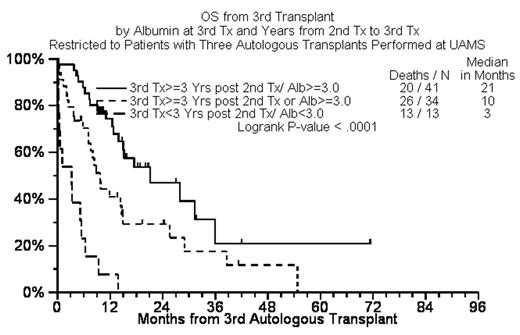Abstract
Tandem autotransplants have recently been reported in the IFM 94 randomized trial to confer more durable event-free survival (EFS) and overall survival (OS) than a single transplant. In the Arkansas program, scheduled tandem transplants have been part of Total Therapy 1 (TT 1) and Total Therapy 2 (TT 2) protocols since 1989 for newly diagnosed patients; this strategy was also applied for the management of previously treated patients. Among a total of 1358 patients receiving two prior autologous transplants at our institution (median interval from 1st to 2nd transplant, 4 mos), 98 received a further autologous transplant. In a search for features associated with favorable post 3rd autotransplant survival, pre-transplant 1, 2 and 3 features, especially the presence of cytogenetic abnormalities (CA) and standard laboratory features such as, B2M, CRP, LDH, albumin, hemoglobin and creatinine were examined along with the time interval from 2nd to 3rd transplant and whether a 3rd transplant was applied to rescue TT 1 or TT 2 front line or other patients receiving tandem transplants as salvage therapy. Remarkably, the presence of CA at any of the indicated time points had no impact on survival after a 3rd autotransplant usually with melphalan 200mg/m2. According to multivariate analysis, the 2nd to 3rd transplant interval (time-dependent covariate analysis) (HR 8.8, p=.002) and hypoalbuminemia < 3.0g/dL (HR 3.2, p<.0001) were independently important. Thus, post 3rd tx survival was superior among the 41 patients with a post-2nd tx survival >3 yr and albumin ≥ 3.0g/dL (median, 21 mos; 5 yr OS 20%), with an intermediate outcome noted for the 34 patients with one of these favorable features present (median, 10 mos; 3 yr 20%) while the worst outcome was noted in the 13 patients who were both hypoalbuminemic and had received their 3rd transplant within 3 yrs of the 2nd transplant (median, 3 mos, no survival beyond 12 mos). Our data indicate that meaningful survival can be obtained with a 3rd autotransplant maneuver in approximately 50% of patients who have derived meaningful survival from a 2nd transplant of at least 3 years and have a preserved albumin concentration as an indication of their overall performance status.
Author notes
Corresponding author


This feature is available to Subscribers Only
Sign In or Create an Account Close Modal